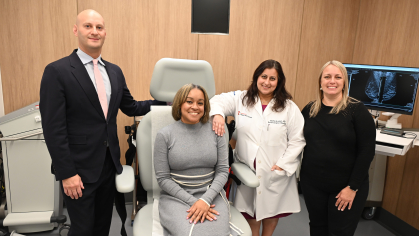Two Rutgers Teams Trace Brain Circuits That Tell Us When to Eat – and When to Stop

Scientists know the stomach talks to the brain, but two new studies from Rutgers Health researchers suggest the conversation is really a tug-of-war, with one side urging another bite, the other signaling “enough.”
Together, the papers in Nature Metabolism and Nature Communications trace the first complementary wiring diagram of hunger and satiety in ways that could refine today's blockbuster weight-loss drugs and blunt their side effects.
One study, led by Zhiping Pang of Robert Wood Johnson Medical School’s Center for NeuroMetabolism, pinpointed a slender bundle of neurons that runs from the hypothalamus to the brainstem.
The cells bristle with GLP-1 receptors, the proteins mimicked by weight-loss drugs such as Ozempic. When Pang’s team hit the pathway with pulses of light, well-fed mice quit eating; when they silenced the circuit or deleted the receptor, the animals packed on weight. Fasting weakened the connection until a burst of natural or synthetic GLP-1 restored it.
“The synapse is a volume knob that only turns up when energy stores are low,” Pang said, warning that drugs that keep the signal high around the clock could disrupt the brain’s normal rhythm and create some of the side effects of GLP-1 drugs such as nausea, vomiting, constipation or diarrhea and muscle wasting.
For the other paper, Mark Rossi, who co-leads the Center for NeuroMetabolism with Pang, charted the circuit that triggers hunger. His group traced inhibitory neurons in the stria terminalis to similar cells in the lateral hypothalamus.
When researchers triggered the connection, a suddenly hungry mouse would sprint for sugar water; when they blocked it, the animals lounged even after a long fast.
Hormones modulated the effect. An injection of ghrelin, the gut’s hunger messenger, revved food seeking, while leptin, the satiety signal, slammed it shut. Overfed mice gradually lost the response, but it returned after diets made them thin again.
“Pang’s pathway shuts things down,” Rossi said. “Ours steps on the accelerator.”
Although the circuits sit in different corners of the brain, members of both teams saw the same principle: Energy state rewires synapses quickly. During a fast, the hunger circuit gains sensitivity while the satiety circuit loosens; after a meal, the relationship flips.
It is the first time researchers have watched the push-pull mechanism operate in parallel pathways, a yin-yang arrangement that may explain why diets and drugs that treat only one side of the equation often lose power over time and may help in making drugs that work even better than today’s generation of GLP-1 medications.
GLP-1 mimics such as Wegovy and Zepbound can trigger double-digit weight loss but also nausea, diarrhea and, in some cases, muscle wasting. Pang’s data suggest a therapy targeting only the brainstem circuit and sparing peripheral organs might curb eating without the side effects. Conversely, Rossi’s work hints that restoring the body’s response to the hunger-regulating hormone ghrelin could help dieters who plateau after months of calorie cutting.
Both projects relied on the modern toolkit of neural biology – optogenetics to fire axons with laser light, chemogenetics to silence them, fiber-optic photometry to watch calcium pulses and old-fashioned patch-clamp recordings to monitor single synapses. Those techniques allowed the researchers to tune individual pathways with a precision that has only recently become possible.
Follow-up work from both teams will explore more questions that could improve drug design. Pang wants to measure GLP-1 release in real time to see whether short bursts, rather than constant exposure, are enough to calm appetite. Rossi is cataloging the molecular identity of his hunger-trigger cells in hopes of finding drug targets that steer craving without crushing the joy of eating.
“You want to keep the system’s flexibility,” Rossi said. “It’s the difference between dimming the lights and flicking them off.”
Allowing the brain to correctly rebalance the desire to eat or stop eating throughout the day, rather than using drugs to keep desire constantly low, may be an important ingredient in tomorrow’s weight-loss prescriptions.


